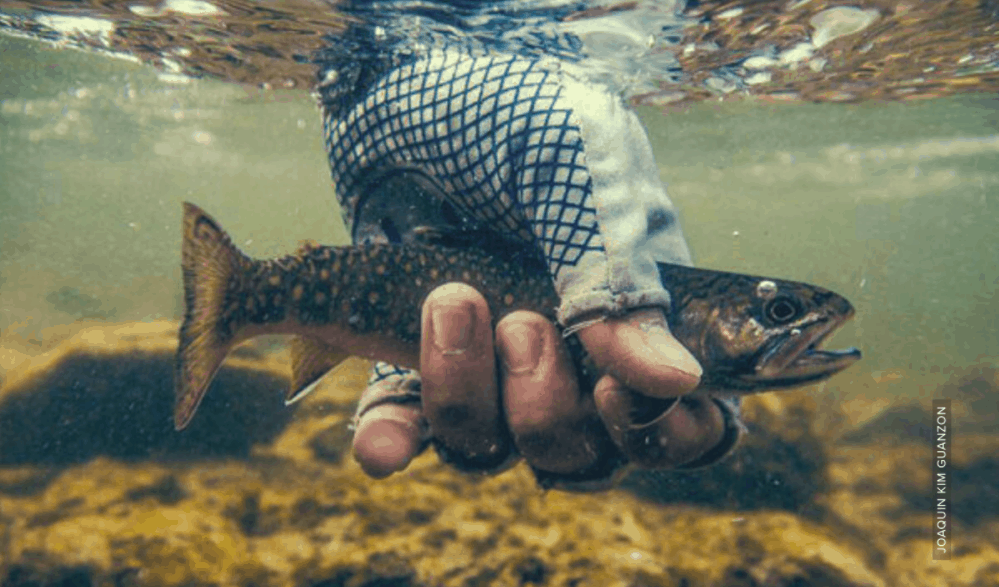CATCH AND RELEASE
PRINCIPLES AND PRACTICES
by Jack Williams
An excerpt from the Tenkara Magazine 2015
One of the true joys of fishing is not only catching fish, but realizing that you have released
them in a good, healthy condition. Proper catch-and-release practices are intended to help
anglers return the fish to its habitat in the best possible shape. Catch-and-release fishing
starts before you step foot in the water. The angler must be armed not only with the
proper equipment but knowledge of fish stress and how to minimize it.
I work at Trout Unlimited, where our staff scientists recently completed a review of the science
behind fish stress, The Science of Fish Stress, Dan Dauwalter, Ph.D, Trout Unlimited Fisheries
Scientist..1 Armed with this knowledge, it seems appropriate to report on what we have learned and
how it can be applied to Tenkara fishing.
THE SCIENCE OF FISH STRESS
Fish are injured or stressed by capture, handling, and air exposure. Injuries from improper capture
and handling can occur to the jaws, gills, internal organs, scales, and surrounding mucous layer.
Blood chemistry can change dramatically as the levels of the stress hormone Cortisol rise. These
changes can cause immediate mortality or more likely, delayed mortality, poor swimming performance and
the inability to avoid predators, increased susceptibility to disease, and other behavioral changes.
Just because a fish is released and swims away does not mean it was not harmed. Fortunately, as
our understanding of fish stress has improved, so has our understanding of how to minimize stress
and injury to our quarry.
PRINCIPLE 1: HAVE THE RIGHT EQUIPMENT
Tenakara anglers are minimalists compared to other fly fishers. Proper technique is more important
than the gear and should extend to catch-and-release techniques. Flies should be barbless. If you use a net, the mesh or bag should be made of rubber or other smooth knotless material that allows the
angler to gently cradle the fish and cause minimal disturbance to the scales and surrounding mucous
layer. The long Tenkara rod and short line allow the angler to bring a fish in quickly. A quick retrieve
will minimize stress.
PRINCIPLE 2: HANDLE WITH CARE
Proper handling applies to fish of all sizes. When bringing the fish in, it is better to slowly drag the
fish across the surface rather than lift it well above with water with the fish suspended from the hook.1
Fish Stress from Catch and Release Fishing by Dan Dauwalter available at www.tu.org ?? The fish should be held
gently, whether in hand or net. Gently restrain the fish to minimize sudden movements or the potential
for its body to slap against rocks or other nearby surfaces. Scientists have little research about the
importance of holding a fish horizontally rather than vertically, but it makes sense to hold a fish more or
less horizontally as fish that are held vertically appear more susceptible
to internal injury. Remove the hook as quickly as possible. A net may allow you to minimize handling
and keep the fish in the water. Before netting the fish, dip the mesh bag in water to help maintain a
slick, cool surface to land the fish. Similarly, if landing by hand, keep your hand wet and near the water
surface.
PRINCIPLE 3: MINIMIZE AIR EXPOSURE
After fish are brought to hand, they are often kept out of the water for hook removal or photographs.
During this time, the exchange of oxygen at the gills is largely eliminated. It’s like running a race and
then not being able to breathe at the finish. Anglers should minimize the amount of air exposure. If
you have to hold the fish out of water, try to keep the duration of air exposure limited to 20 seconds or
less.
PRINCIPLE 4: FACILITATE RECOVERY IF NEEDED
For many Tenkara anglers, handling stress can be kept to a minimum and the fish are in adequate
condition for a quick release. If however, hook removal was time-consuming or the time to hand was
extensive, it may be important to facilitate recovery. To help the fish recover, gently support the fish in
slow moving water so that water can flow through the mouth and over the gills until the fish can swim
away.
PRINCIPLE 5: LIMIT FISHING WHEN THE HEAT IS ON
High stream temperatures and low flows can put additional stress on trout and other coldwater fishes.
Fish may become more vulnerable to disease, and competition for space and food are likely to increase
during drought. For these reasons, anglers should avoid adding additional stress to fish populations
during these extreme conditions. Anglers should consider fishing only during cooler morning hours or
moving to waters that are less severely impacted.
CONCLUSION
By its nature, Tenkara fishing should have minimal impact on the health and condition of fish that are
caught. Long rods, short lines, barbless hooks, and the frequent use of nets are likely to help minimize
fish stress, especially when the above principles are applied. That is good for the fish and the angler.
It’s all part of the joy of fishing.
Jack E. Williams is the senior scientist for Trout Unlimited. He lives in Oregon’s Rogue River Valley.
